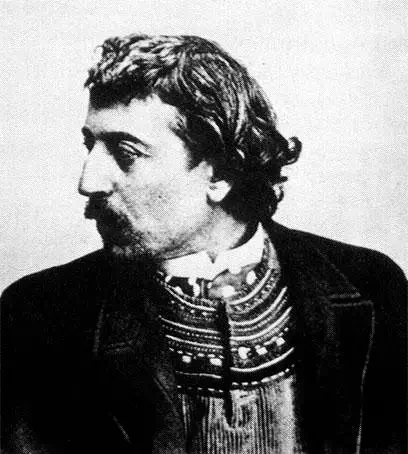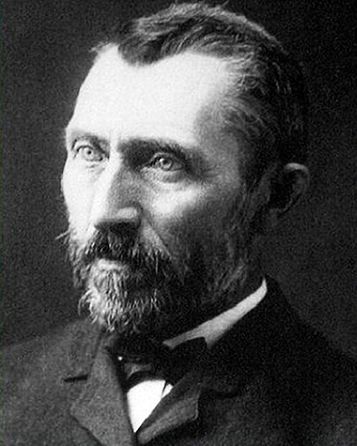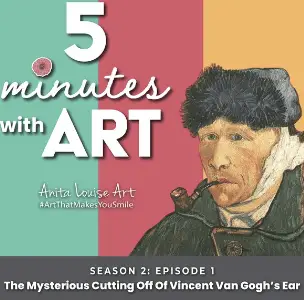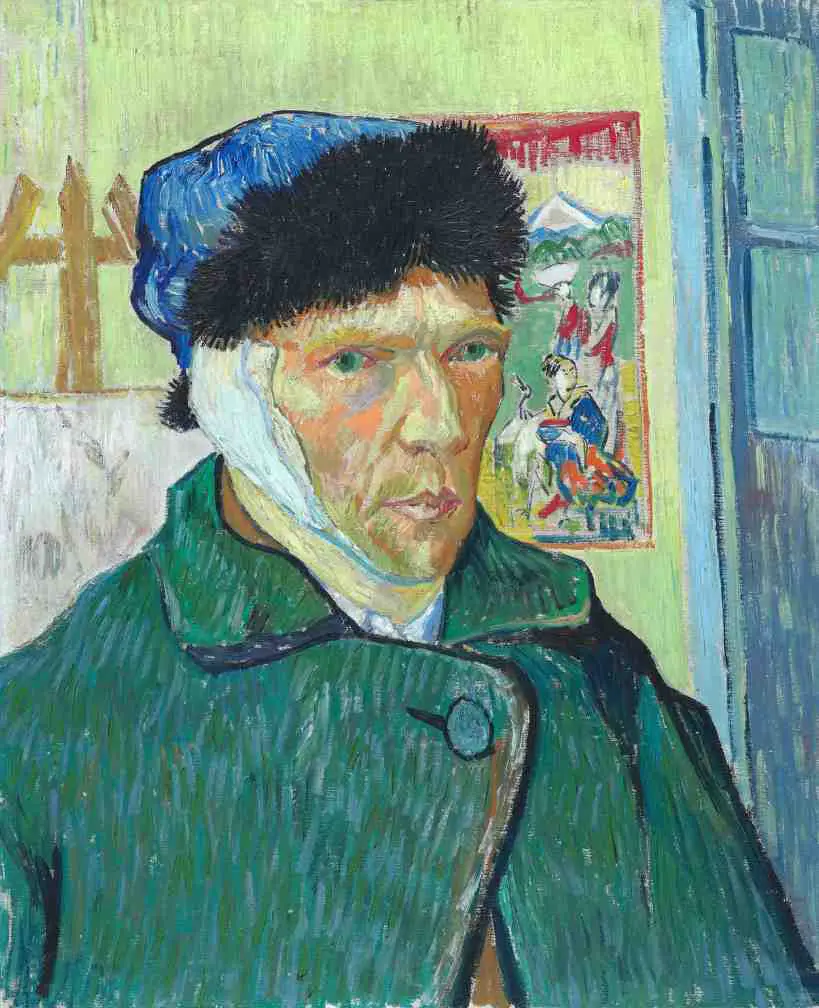One of the most famous stories about Vincent van Gogh is that he cut off his ear. The mystery remains of why Vincent van Gogh cut off his ear and why the episode is an integral part of art history.
Van Gogh and Paul Gauguin lived together in Arles, France, in the Yellow House, but there was a lot of tension between them. One day Vincent Van Gogh had an acute mental illness, so he cut off his ear; he then took his cut-off ear to a local prostitute. This started a series of events that led to the police getting involved and forcing Vincent Van Gogh into the hospital to be treated for mental illness.
Table of Contents
- Vincent Van Gogh’s Ear – Leading Up To the Mystery
- Vincent Van Gogh Cutting Off The Ear Timeline
- Vincent Van Gogh’s Explanation For His Actions
- The Impact Of The Ear Incident On Vincent Van Gogh’s Artistic Legacy
- Frequently Asked Questions
- Related Questions
Vincent Van Gogh’s Ear – Leading Up To the Mystery
One of the great art mysteries is why Vincent van Gogh cut off his ear. In December 1888, the Dutch post-impressionist artist cut off the lower part of his left ear.
Many believe the lead-up to this was Vincent Van Gogh’s disagreement with Paul Gauguin and how they were not getting along. Gauguin felt it was affecting his work and Vincent’s artwork.
Paul Gauguin And Vincent Van Gogh’s Relationship


The relationship between Paul Gauguin and Vincent Van Gogh, who shared the little yellow house in Arles, became increasingly fraught. They were having a hard time getting along.
The house must have been filled with tension and disagreement with fellow artist Paul Gauguin, whom he was living in the Yellow House In Arles. Vincent Van Gogh was happy in Arles but struggled with his relationship with his fellow artist Paul Gauguin.
Paul Gauguin wrote to Theo Van Gogh on December 11, 1888, about his relationship with Vincent Van Gogh:
“Vincent and I can absolutely not live side by side without trouble, as a result of incompatibility of temperament, and both he and I need tranquillity for our work. He is a man of remarkable intelligence, whom I greatly respect and whom I leave with regret, but I repeat, it is necessary.”
Paul Gauguin to theo Van Gogh – 11 December 1888
This letter was written just a few weeks before Vincent Van Gogh cut off his ear.
Vincent Van Gogh Cutting Off The Ear Timeline

On the evening of December 23, 1888, Vincent Van Gogh suffered an acute mental breakdown. Some have speculated that he could have had lead poisoning because the paints he was using had high levels of lead pigments; the high levels of lead pigments could have caused hallucinations and other symptoms that could have seemed like mental illness.
Another theory is that Vincent Van Gogh had bipolar disorder, leading to hallucinations and manic episodes. Or others thought maybe it was due to some drugs the doctors had prescribed; he was taking digitalis medications for a heart condition.
Timeline for Van Gogh Cutting Off His Ear
But what we do know about this timeline for cutting off the ear incident is the following:
- Late November, Early December 1888 – Vincent Van Gogh and Paul Gauguin’s differences started to intensify.
- Mid-December 1888 – Paul Gauguin decided to move away from Arles and back to Paris.
- Evening December 23, 1888 – Vincent Van Gogh suffered an acute mental breakdown. He took a razor and cut off part of his left ear.
- Later Evening December 23, 1888 – He then took the ear he had cut off and tried to give it to a prostitute at a local brothel. It scared the poor girl so much the police were called.
- Morning December 24, 1888 – The police found Vincent Van Gogh at home in the yellow house and forced him to be admitted to the hospital.
- December 24, 1888 – Paul Gauguin sent a telegraph to Theo, Vincent’s brother, and Theo immediately took the night train from Paris to Arles. France.
- December 25, 1888 – Theo visits Van Gogh in the hospital and realizes there is not much he can do. He describes Van Gogh as being incoherent.
- End of December – Both Theo and Paul Gauguin returned to Paris. Even though Vincent repeatedly asked for Paul Gauguin to come to see him in the hospital, he refused and never went to see him.
- January 7, 1889 – Vincent was in the hospital until the doctor suggested he needed to move to a mental asylum.
In speaking of seeing his brother Theo Van Gogh wrote this to Jo Bonger Van Gogh:
“I found Vincent in the hospital in Arles. The people around him realized from his agitation that for the past few days he had been showing symptoms of that most dreadful illness, of madness, and an attack of fièvre chaude, when he injured himself with a razor, was the reason he was taken to hospital. Will he remain insane? The doctors think it possible, but daren’t yet say for certain. It should be apparent in a few days’ time when he is rested; then we will see whether he is lucid again. He seemed to be all right for a few minutes when I was with him, but lapsed shortly afterwards into his brooding about philosophy and theology. It was terribly sad being there, because from time to time all his grief would well up inside and he would try to weep, but couldn’t. Poor fighter and poor, poor sufferer. Nothing can be done to relieve his anguish now, but it is deep and hard for him to bear.”
Theo Van Gogh To Jo Bonger Van Gogh -28 Dec 1888
We can learn from this letter his brother wrote what a lousy state Vincent Van Gogh was in after he cut off his ear and that mentally he was not doing well at all. It was because he did not quickly show signs of improvement that Vincent Van Gogh was sent to the mental asylum.

Listen To Our Podcast About The Mysterious Cutting Off Of Vincent Van Gogh’s Ear by clicking here.
Vincent Van Gogh’s Explanation For His Actions
Vincent Van Gogh never said precisely why he chose to mutilate his ear. But in the week following the incident, rumors were circulating about exactly what happened on the night and questions about when Van Gogh cut off his ear.
He said he had been out drinking with some friends before returning home to find his friend Paul Gaugin asleep. He felt frustrated by the disagreement over the art and Gauguin’s decision to leave him alone in Arles.
Overcome with frustration, he took out a razor blade and cut off his ear. He then took the cut-off ear and visited a prostitute who lived nearby as “proof” of his love for her.
The fact he went to give the ear to the prostitute, of course, did not sit well with the brothel as it caused quite a commotion and also set in motion for the police to be involved and to force Van Gogh to the hospital.
In speaking of this incident, Van Gogh said this later in a letter to his brother:
“You’ll perhaps understand that what would reassure me in some way regarding my illness and the possibility of a relapse would be to see that Gauguin and I didn’t exhaust our brains for nothing at least, but that good canvases result from it.”
Vincent Van Gogh To his Brother Theo – 28 January 1889
Even in this time of despair, Vincent Van Gogh felt that they could be learned from this experience that would help him improve his art and help to make him a better artist.
The Impact Of The Ear Incident On Vincent Van Gogh’s Artistic Legacy
Despite the gruesome nature of van Gogh’s self-mutilation, it has come to be seen as a symbol of his passion as an artist and the suffering he endured throughout his life due to mental health issues. In some way, it shows him and all his imperfections to us even more as an artist and human beings.

He even painted a self-portrait with his ear bandaged up. So we have a record today of what it looks like for him to have his ear and head all bandaged.
At the same time, the self-mutilation of the ear is also an incident that remains shrouded in mystery. We know the circumstances which led up to him cutting off his ear, but we do not fully understand from him the reason why; the truth is that he may not fully understand why he cut off his ear.
Vincent Van Gogh’s self-mutilation is one of history’s greatest mysteries to which we may never know the answer. But regardless if we discover precisely what happened or not, we know for sure that it serves as a reminder of the immense suffering of mental illness and mental health issues.
Anita Louise Art is dedicated to art education, great artists, and inspiring others to find and create their art. We love art that uplifts and inspires. #ArtToMakeYouSmile! #ArtToMakeYouHappy!
If you are interested to see any of my art, you can find out more by clicking here. If you are interested in what inspires me and my paintings, you can discover more by clicking here.
We have a free newsletter and would love you to be part of our community; you can subscribe to the newsletter by clicking here. If you have any questions, I would be happy to talk to you anytime. You can reach me, Anita, by clicking here.
Subscribe to our Anita Louise Art YouTube Channel with great videos and information by clicking here.
Join us for our podcast “5 Minutes With Art.” Spend just 5 minutes a week with us to discover and learn about great art and artists. You can find out more about our podcast by clicking here.
Frequently Asked Questions
Who was Vincent Van Gogh?
Vincent Van Gogh was a Dutch post-impressionist painter who is considered one of the most influential figures in Western art history.
When was Vincent Van Gogh born and when did he die?
Vincent Van Gogh was born on March 30, 1853, and he died on July 29, 1890.
What are some of Vincent Van Gogh’s most famous paintings?
Some of Vincent Van Gogh’s most famous paintings include “Starry Night,” “Sunflowers,” “The Starry Night Over the Rhône,” and “Irises.”
Did Vincent Van Gogh achieve success during his lifetime?
No, Vincent Van Gogh only sold one painting during his lifetime and struggled with poverty and mental illness throughout his career.
Why is Vincent Van Gogh considered an important artist?
Vincent Van Gogh’s bold use of color and expressive brushwork paved the way for modern art movements like Expressionism. His emotional and psychological struggles also resonate with many people, making his art deeply relatable.
What influenced Vincent Van Gogh’s artistic style?
Vincent Van Gogh was influenced by various artistic movements and artists, including Impressionism, Japanese woodblock prints, and the works of Jean-François Millet and Paul Gauguin.
What is the story behind Vincent Van Gogh cutting off his ear?
The exact reason why Vincent Van Gogh cut off his ear remains a mystery. It is believed to be a result of a severe mental breakdown and his tumultuous relationship with Paul Gauguin. Some speculate it was a desperate cry for help or a way to express his emotional anguish.
Did Vincent Van Gogh really give his cut-off ear to a prostitute?
Yes, it is reported that after cutting off his ear, Van Gogh wrapped it in newspaper and presented it to a woman named Rachel, who was a local prostitute.
Related Questions
Which Ear Did Van Gogh Cut Off Left Or Right? And Other Facts
Vincent Van Gogh cut off his left ear; he painted several paintings of himself with the bandaged ear. The events leading up to the ear cutting were because of artistic disagreements with the artist Paul Gauguin. Cutting off his left ear made the local newspaper’s front page and set off a chain of events that would change Vincent Van Gogh’s life forever.
By clicking here, you can discover more by reading Which Ear Did Van Gogh Cut Off Left Or Right? And Other Facts.
Why Did Vincent Van Gogh Commit Suicide?
Vincent Van Gogh had a mental illness; many believe he was manic-depressive. He was also sad and lonely and felt a huge financial burden. He committed himself to the mental hospital for treatment, but all this made it very difficult for him to do what he loved most, which was to paint.
By clicking here, you can learn more by reading Why Did Vincent Van Gogh Commit Suicide?
Why Are Vincent Van Gogh’s Paintings So Valuable?
Vincent van Gogh was an extremely prolific artist who painted over 900 works of art during his short lifetime. His work is appealing, and his use of colors and brushstrokes help make his art genuinely unique. He inspired many art movements and artists, and Van Gogh left us a legacy of his art and his letters and thoughts.
By clicking here, you can discover more by reading Why Are Vincent Van Gogh’s Paintings So Valuable?

